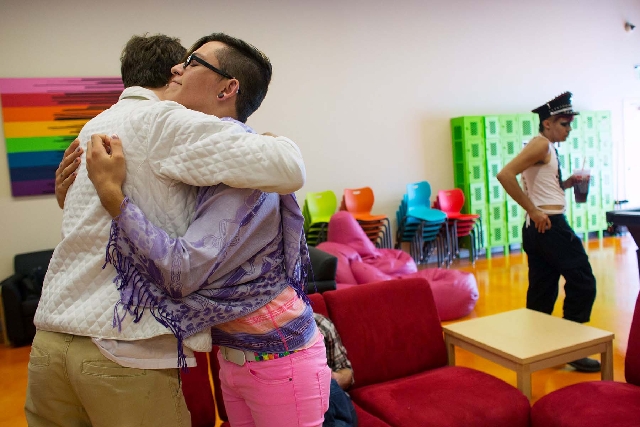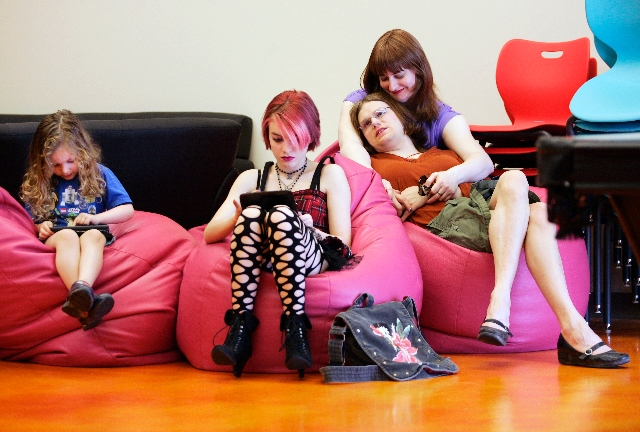The Center’s new home gives gay, lesbian, transgender locals a hub
Drinking Drano.
That was one kid’s solution to the pain of living as a young gay man in Las Vegas during the 1990s.
His parents were staunchly anti-gay and he had nowhere to turn for support or advice. He saw no reason to continue his uphill struggle to gain acceptance.
That teenager lived to discover The Gay & Lesbian Community Center of Southern Nevada in the late 1990s. Bob Bellis, who served as The Center’s executive director from 1999 to 2004, is still in touch with him today.
Through all the years he worked at The Center, the battles he’s fought and the milestones he’s helped achieve, Bellis most remembers the kid who drank Drano in an attempt to kill himself.
That, Bellis says, is why the valley needs a center dedicated to the lesbian, gay, bisexual and transgender community.
“I still see homeless kids who get kicked out of their homes because they’re gay,” says Bellis, who now works at Nevada Partnership for Homeless Youth. “Even with the progress of the last few years, the center is still needed to help kids like that.”
Last week, The Center opened a new $4 million building in downtown Las Vegas. The 16,000-square-foot Robert L. Forbuss Building is The Center’s first freestanding building in its 20-year history. The Center, which is in a residential neighborhood on Maryland Parkway at Lewis Avenue, now has the space and resources to expand its hours and services, which include social and support groups, free HIV testing and flu shots. There’s a health and wellness center with a private entrance, a children’s play area, conference rooms, a cafe, a library and 4,000 square feet of outdoor courtyard space.
The building was a well-known paint store built in the 1970s. When they decided to move from the Commercial Center on Sahara Avenue, The Center’s staff and board members considered several potential locations. They settled on the downtown location because the majority of the youths who use The Center’s programs live in the surrounding ZIP codes, says Candice Nichols, The Center’s senior director of programs and community partnerships. She previously served as executive director.
“Now I get why a center is so important,” says Nichols, 59.
Nichols, a lifelong valley resident, has spent the past eight years immersed in the troubles and triumphs of Southern Nevada’s LGBT community. She worked closely with young people who struggled to find acceptance or a safe place where they wouldn’t be ridiculed or abused for being gay.
It makes a difference in people’s lives, she says. Sometimes, it even saves people’s lives.
■ ■ ■
The Center opened its first physical location in 1993 in a former dental office on Sahara Avenue near Maryland Parkway. The concept had been discussed for a good 10 years before it happened, says local historian Dennis McBride. He has a book coming out that details the history of Nevada’s LGBT community.
It was a terrible building, says former center director Bellis. The dental sinks leaked. At only 1,200 square feet, there wasn’t much space for programs or meetings. But it was a beginning. And it was a major step forward for the local LGBT community.
There had been de facto centers — a local church offered space for weekly meetings; businessman Rob Schlegel hosted youth group meetings in his office — but those places had other missions. For the first time, the LGBT community had a meeting place that was strictly dedicated to them. And it wasn’t a bar.
“It was a tremendous year for the community,” McBride says of 1993. “That year, the state legislature repealed the sodomy law in Nevada. That was probably the most important legislative thing that could have happened for us. The Center opening that same year gave it a resonance it might not have had otherwise.”
Its primary mission was to provide a clearinghouse for information to LGBT youths. Kids had nowhere to hang out in Las Vegas, McBride says. Gay kids especially lacked resources.
“The Center was a place for gay youth to go,” he says. “You’ve got to have a protected space for gay kids because they get the short end of every stick.”
McBride, 58, is a native Nevadan. In 1965, he came out. He was in the sixth grade.
“That didn’t go over too well,” McBride recalls.
He endured harassment and bullying from his schoolmates. He didn’t understand the homophobic slurs they hurled at him; he just knew being gay was getting him into a whole lot of trouble. So McBride shut down emotionally. He struggled with his sexuality until his freshman year of college, when he came “exploding out of the closet.”
There was no gay community center to turn to when McBride was growing up. He handled the stress and bullying the only way he knew how: by collecting things. He gathered everything he could get his hands on, collecting pieces of Las Vegas gay history as it was happening. The actions shaped his life and ultimately led him to a career as an official historian. McBride now serves as director of the Nevada State Museum.
A center, he says, would have made a difference in his life. It would have given him a place to turn to for direction, education and support.
■ ■ ■
Without The Center, Taylor Johns, 22, doesn’t know where he would be or how his life would have turned out. When he was 15, a counselor suggested he check out The Center’s youth programs.
“I was going through a lot then with my family and my school. It was a safe place,” Johns says. “With everything that was going on in my life, I knew when I walked through those doors, being gay was one less thing I had to worry about.”
Every Tuesday, he attends a youth group where teenagers and young adults gather to talk about their lives. They boost each other, often just by their physical presence. Many take comfort in knowing they’re not alone.
On a recent Tuesday, Johns plays pool with a couple of friends in The Center’s youth room. Nearby, others huddle together with serious expressions as they create messages to post on Facebook about National Youth HIV & AIDS Awareness Day.
They are all young and gay. Without The Center, they may have never found each other.
“This center is so important to the community,” says Jan Jones, former Las Vegas mayor and honorary chairwoman of The Center’s capital fundraising campaign. “It’s a place where young people can go and find comfort, direction and mentors.”
■ ■ ■
In 2002, The Center moved from the dentist office into a storefront in the Commercial Center. Then, in 2006, The Center moved a few doors down in the same shopping center, into a roughly 6,000-square-foot space.
The space was big, but it needed work. There were no walls or bathrooms but it was still a step up, McBride says. The Center’s services grew.
When Nichols took over as executive director in 2004, The Center’s annual budget was about $139,000. There were two staff members, including Nichols. Now, The Center’s annual operating budget is $1.2 million and there are 11 people on staff.
The Center has experienced explosive growth in the past three years, Nichols says. In 2011, The Center kicked off a capital fundraising campaign. It was part of a five-year strategic plan that culminated with a state-of-the-art facility.
Former Mayor Jones has been a sort of godmother to Southern Nevada’s gay community ever since she was elected in 1991. As honorary chairwoman of the capital campaign, she committed to raising $1 million in honor of The Center’s namesake, her best friend Robert Forbuss.
He died last year from complications caused by ALS, or Lou Gehrig’s disease. The two met at a dinner shortly after she was elected. Forbuss became a staunch supporter of The Center, even though he was closeted for many years, Jones says. A successful businessman and former educator, Forbuss faced extraordinary obstacles to coming out. If a man with his resources had trouble accepting himself and being out publicly, imagine what it’s like for a teenager, Jones says.
No one should have to face such difficulties. That’s why, Jones says, she has been a vocal supporter of gay rights.
“When you find ignorance and intolerance, one thing you can do is stand up and use your voice,” she says. “A single voice is meaningful and sometimes you need that voice to lead. But collective power is what changes society. Maybe by using my voice early” it empowered others to use theirs.
In the worst economic climate in decades, The Center was able to raise $4 million in about three years. Many local supporters of The Center believe that demonstrates a major shift in societal beliefs.
It means, Jones says, that the community has come of age. It means they have found their own voice and power.
■ ■ ■
The fundraising success and the new center speaks to a “growing sense of rootedness that Vegas has always lacked,” McBride says. “I’m just tremendously pleased that the community can plop itself down right in the middle of a neighborhood and there’s nothing hidden about it or covert. After years of having to be careful, now there it is, right in the middle of the block, the gay and lesbian community center.”
What this means for The Center’s future is hard to say. Programs and outreach will expand, certainly. Although the opening of the new facility signals a finale of sorts, supporters know that the work is not over. Neither are the rewards.
“Opening isn’t the end,” Jones says. “It’s the beginning.”
Contact reporter Sonya Padgett at
spadgett@reviewjournal.com or 702-380-4564.
Follow @StripSonya on Twitter.





















